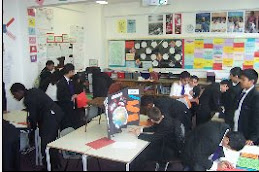I build up to creating our museum exhibition over a few lessons. (The full Scheme of Work can be found here - this one is environment themed)
Lesson 1:

We start brainstorming what a good exhibition looks like, by showing students some examples from past lessons and online. We then brainstorm possible questions and pick the ones we will investigate. I also add in the most important part here: each display must have a display board with words and pictures AND each team must create an interactive model that explains some part of the answer to their question.
Lessons 2 & 3:
 Students research and prepare for 'creation' day. I give each group ONE lesson only to complete the visual parts of their display. On the day they may bring ready-made items in, e.g. written displays or pictures, to stick onto their card, but they will only have 50 minutes. To prepare students for this I give them decision cards. On the cards each team makes decisions about the team member responsible for the model, pictures, writing, etc. [This lesson was observed during our OFSTED and the inspectors loved it because it gave 'structured independence' to the students].
Students research and prepare for 'creation' day. I give each group ONE lesson only to complete the visual parts of their display. On the day they may bring ready-made items in, e.g. written displays or pictures, to stick onto their card, but they will only have 50 minutes. To prepare students for this I give them decision cards. On the cards each team makes decisions about the team member responsible for the model, pictures, writing, etc. [This lesson was observed during our OFSTED and the inspectors loved it because it gave 'structured independence' to the students].Lesson 4:
Creation day!
Lesson 5: The museum bit. So, on the day, students have 10 minutes to set up. Each stand leaves one pupil at the display, ready to explain to passers-by. The rest of us go out into the corridor - with bags and coats if necessary - and we line up. I explain that we are on 'a trip' and that students have worksheets to fill in. "You must treat the museum with respect as you are representing our school and I don't want visitors going away thinking badly of school" I say (cue much good-natured groaning here...). Students go into the classroom, look at each other's exhibitions, ask questions and complete their worksheet. Because every student must complete their worksheet fully, students rotate who stays with the display and who is moving around.
As long as it is set-up properly with good instruction, I have never had this lesson go wrong. Everyone is on-task and enjoying themselves.
Final note: Make sure you have time to pack away or let the next teacher know that you will be late!



